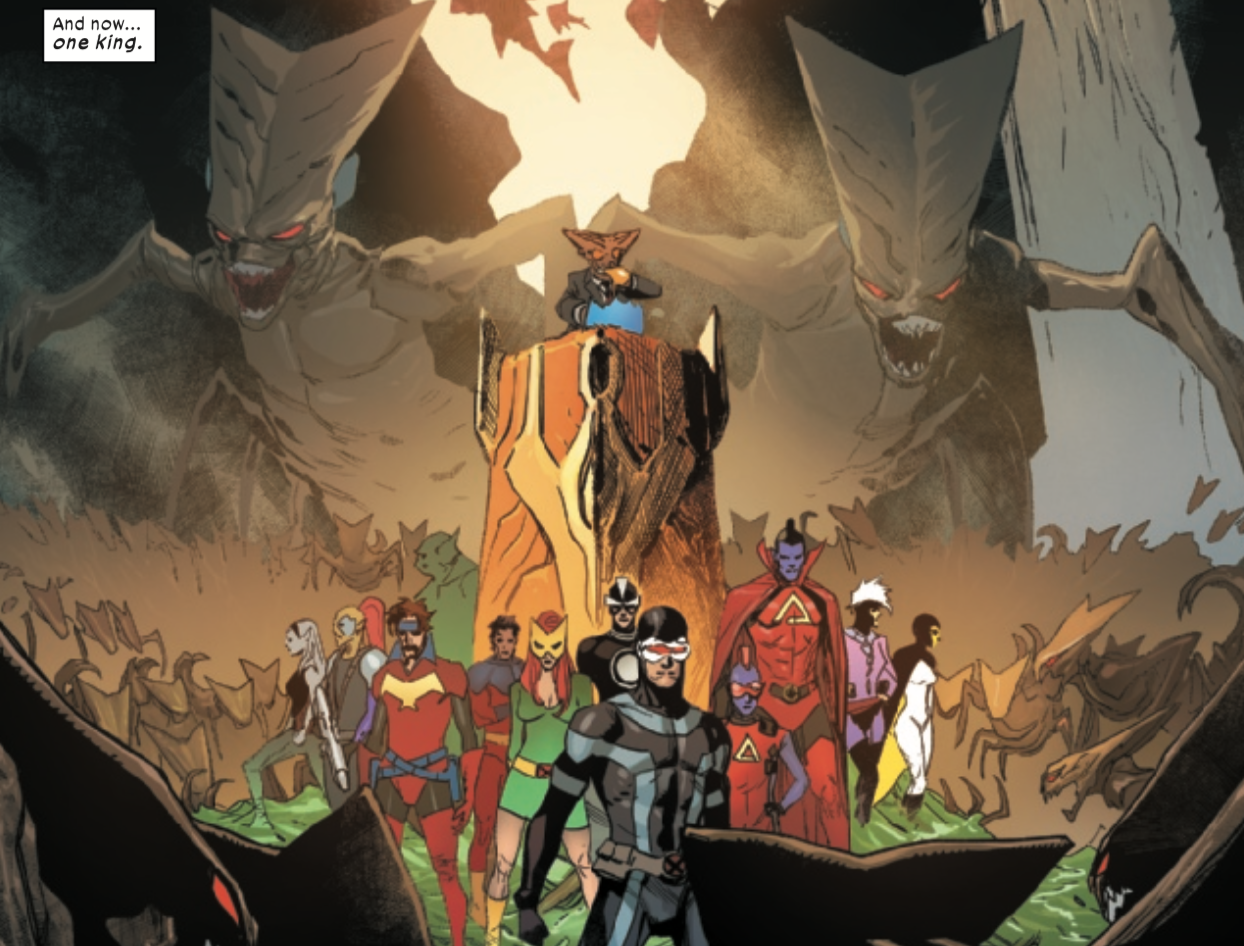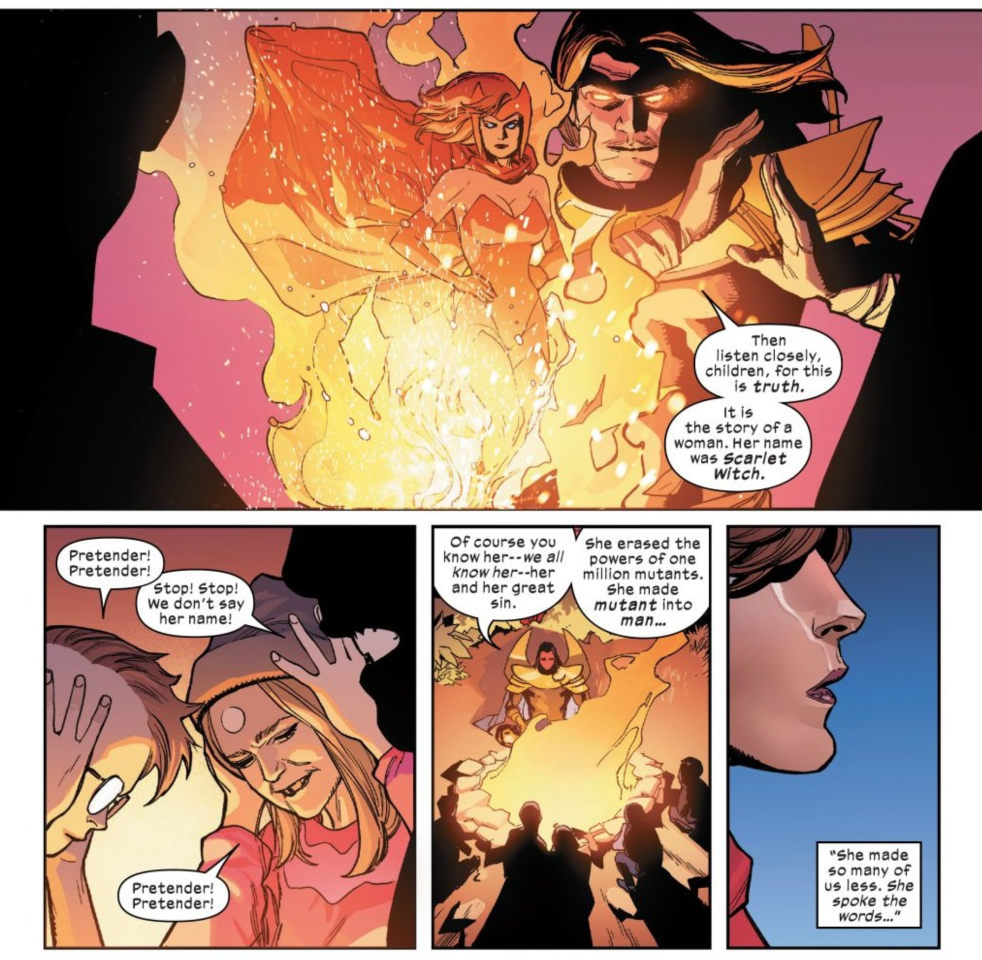Truth
“X of Swords: Chapter 12”
X-Men #14
Written by Jonathan Hickman
Art by Leinil Francis Yu with Mahmud Asrar
Color art by Sunny Gho
“X of Swords: Chapter 13”
Marauders #14
Written by Gerry Duggan and Benjamin Percy
Art by Stefano Caselli
Color art by Edgar Delgado
• I was wondering how Mahmud Asrar was handling the deadline crunch of seemingly getting put on a third of last week’s Stasis special while being assigned to draw four other issues in the crossover, but now we know the answer: He only drew the framing sequences of this issue, and the majority of the issue is made up of repurposed Leinil Francis Yu pages from X-Men #12. Jonathan Hickman has made use of the old “reuse the art” trick before, but this is a particularly bold move, reframing the history of the mutants of Arakko as told to Apocalypse by Summoner from the perspective of Genesis. Whereas Summoner was trying to mislead and trap Apocalypse, Genesis is telling him the hard truth of things. It’s like hearing the same song played in a different, far more melancholy key.
This creative decision is as artful as it probably was quite pragmatic, though it does make you wonder what the compensation deal was like for Yu in this situation.
• It’s interesting to see where Summoner and Genesis’ accounts differ and converge, with some bits of their stories perfectly aligning on particular panels. The most blatant deviations come towards the end of the story, with Genesis revealing that the demons of Amenth had bred captured mutants to create a hybrid warrior race and the demon conjuring Summoners, and that Genesis indeed killed the prior host of Annihilation and was obligated to wear the Golden Helm of Amenth and command its armies. And though she put this fate off for many years, she eventually gave in and all of Arakko succumbed to Amenth. This led to the conquest of Dryador, and onward to the next goal of taking Krakoa. The final text page of this issue is heartbreaking, spelling out the truth of Arakko: The mutants there are “prisoners in their own land,” oppressed by the Amenthi hybrids, the Summoners, and the Golden Helm. What was previously implied is now very clear – Arakko must be liberated from Amenth and the mutants loyal to Amenth.
• Isca the Unbeaten plays an interesting role in this story – her power to never lose compels her to side with inevitable victors, which directly led to her sister Genesis being corrupted by Annihilation and Arakko falling to Amenth. She’s a narrative echo of Cylobel from Powers of X, who was bred by Nimrod to betray her fellow mutants, but the notion of people who are genetically compelled to turn against their own is an odd and potentially contentious theme for Hickman’s macro story. However, just as Cylobel turns against Nimrod, it seems very likely that Isca will side with Krakoa by the end of this story. But whereas this is a redemptive act for Cylobel, wouldn’t this just be another convenient turn of events for Isca? And besides, how exactly is surrendering one’s loyalties not a form of being beaten?
• The “vile schools” of mutant-Amenthi hybrid warriors is another echo of a plot point from Powers of X – the breeding of chimera as a warrior class of mutants by Mister Sinister. And what’s going to be the comic in this storyline to really engage with the vile schools? Hellions, the series featuring Mister Sinister as the lead.
• There’s such a sad poetry in Apocalypse having to face this brutal survivalist ethos he’s been living with for centuries from the perspective of now having Krakoa, and seeing in Krakoa a real possibility of true mutant culture and prosperity that is entirely alien to these Arakki people who can only see a zero sum game of survival or destruction. Genesis sees only softness and weakness in Apocalypse and Krakoa, but she has lost all context for true civilization. The Arakki fight merely to conquer and survive in their miserable lives, but the people of Krakoa have something to truly treasure and protect. Genesis is blind to the power of that motivation.
• Marauders #14 is a welcome tonal shift from X-Men #14, reorienting the story back to the perspective of the X-Men swordbearers as they meet their counterparts from Arakko for the first time at a banquet hosted by Saturnyne. Much of the story focuses in on Storm, who carries herself with absolute confidence as she rebuffs the romantic advances of Death, and on Wolverine, who is openly contemptuous of Brian Braddock for not taking advantage of Saturnyne’s love for him to prevent the tournament. There’s also a fantastic little scene in which the Krakoan captains Magik and Gorgon look for weaknesses in their opponents and test Isca, who manages to spook even them.
• Stefano Caselli noticeably steps up his game for this issue, and really outdoes himself in drawing the surreal banquet hall of the Starlight Citadel. He does some stellar work with body language and facial expressions through the issue, and is particularly impressive in how he conveys so many distinct personalities and interpersonal dynamics in the party scenes. He was very well cast for this sequence of the story.
• Since starting this site I’ve paid a lot more attention to X-Men comics fandom, and doing that can be like stepping into a weird alternate universe in which everyone dislikes Wolverine and finds him boring. I can’t relate. But this issue, as with most Wolverine comics written by Benjamin Percy, makes a great case for why he’s such a widely beloved character. His brutish no-bullshit attitude is a necessary contrast with the pomp and circumstance of Saturnyne’s banquet and the absurd formality of her contest. When he stabs her on the last page it is a genuinely cathartic moment, even though it’s quite clear there’s no way he’s successful in this tactic.

































